Process Development of Screen-Printed Magnetic Sheets for Electric Machines via Statistical Design of Experiments
Abstract
:1. Introduction
2. Materials and Methods
2.1. Manufacturing Process for Printed Magnetic Sheets
2.1.1. Powder Processing and Paste Production
2.1.2. Screen Printing and Drying
- Vth = theoretical ink volume;
- w = mesh size;
- d = filament diameter;
- D = fabric thickness.
2.1.3. Debinding and Sintering
2.1.4. Handling, Coating and Stacking to Sheet Packages
2.2. Methodology
2.3. Measurement Systems
2.4. Experimental Setup
3. Results and Discussion
3.1. DoE 1: Variable Screen Printing Parameters
- Squeegee velocity: 240 mm/s;
- Take-off: 3 mm;
- Roller mill: Yes.
3.2. DoE 2: Print Mode
3.3. DoE 3: Screen Type
3.4. DoE 4: Squeegee Angle
4. Conclusions
Author Contributions
Funding
Data Availability Statement
Acknowledgments
Conflicts of Interest
References
- Ouramdane, O.; Elbouchikhi, E.; Amirat, Y.; Sedgh Gooya, E. Optimal Sizing and Energy Management of Microgrids with Vehicle-to-Grid Technology: A Critical Review and Future Trends. Energies 2021, 14, 4166. [Google Scholar] [CrossRef]
- Martyushev, N.V.; Malozyomov, B.V.; Khalikov, I.H.; Kukartsev, V.A.; Kukartsev, V.V.; Tynchenko, V.S.; Tynchenko, Y.A.; Qi, M. Review of Methods for Improving the Energy Efficiency of Electrified Ground Transport by Optimizing Battery Consumption. Energies 2023, 16, 729. [Google Scholar] [CrossRef]
- Kapetanović, M.; Vajihi, M.; Goverde, R.M.P. Analysis of Hybrid and Plug-In Hybrid Alternative Propulsion Systems for Regional Diesel-Electric Multiple Unit Trains. Energies 2021, 14, 5920. [Google Scholar] [CrossRef]
- Europa.eu. European Commission. Available online: https://op.europa.eu/en/publication-detail/-/publication/158e48ba-a1c7-11e8-99ee-01aa75ed71a1/language-sl (accessed on 7 July 2023).
- European Environment Agency (EEA). Verkehr. Available online: https://www.eea.europa.eu/de/themes/transport/intro (accessed on 21 July 2023).
- Waide, P.; Brunner, C. Energy-Efficiency Policy Opportunities for Electric Motor-Driven Systems International; Working Paper; International Energy Agency (IEA): Paris, France, 2011. [Google Scholar]
- Chapman, S.J. Electric Machinery Fundamentals, 5th ed.; McGraw-Hill: New York, NY, USA, 2005; Volume 1999, p. 1991. ISBN 978-0-07-352954-7. [Google Scholar]
- Libert, F.; Soulard, J. Manufacturing Methods of Stator Cores with Concentrated Windings. In Proceedings of the 3rd IET International Conference on Power Electronics, Machines and Drives—PEMD, Dublin, Ireland, 4–6 April 2006. [Google Scholar]
- Lamprecht, E.; Hömme, M.; Albrecht, T. Investigations of eddy current losses in laminated cores due to the impact of various stacking processes. In Proceedings of the 2nd International Electric Drives Production Conference (EDPC), Nuremberg, Germany, 15–18 October 2012; pp. 1–8. [Google Scholar] [CrossRef]
- Stornelli, G.; Faba, A.; di Schino, A.; Folgarait, P.; Ridolfi, M.R.; Cardelli, E.; Montanari, R. Properties of Additively Manufactured Electric Steel Powder Cores with Increased Si Content. Materials 2021, 14, 1489. [Google Scholar] [CrossRef] [PubMed]
- Tiismus, H.; Kallaste, A.; Belahcen, A.; Tarraste, M.; Vaimann, T.; Rassõlkin, A.; Asad, B.; Shams Ghahfarokhi, P. AC Magnetic Loss Reduction of SLM Processed Fe-Si for Additive Manufacturing of Electrical Machines. Energies 2021, 14, 1241. [Google Scholar] [CrossRef]
- Cramer, C.; Yan, P.; Evans, S.F.; Elliott, A.M.; Chinnasamy, C.; Paranthaman, M.P. Binder jet additive manufacturing method to fabricate near net shape crack-free highly dense Fe-6.5 wt.% Si soft magnets. Heliyon 2019, 5, e02804. [Google Scholar] [CrossRef] [PubMed]
- Pham, T.; Suen, H.; Kwon, P.; Foster, S. Characterization of Magnetic Anisotropy for Binder Jet Printed Fe 93.25 Si 6.75. In Proceedings of the IEEE Energy Conversion Congress and Exposition (ECCE), Baltimore, MD, USA, 29 September–3 October 2019. [Google Scholar] [CrossRef]
- Nartu, M.S.K.K.Y.; Jagetia, A.; Chadhary, V.; Mantri, S.A.; Ivanov, E.; Dahotre, N.B.; Ramanujan, R.V.; Banerjee, R. Magnetic and mechanical properties of an additively manufactured equiatomic CoFeNi complex concentrated alloy. Scr. Mater. 2020, 187, 30–36. [Google Scholar] [CrossRef]
- Chadhary, V.; Nartu, M.S.K.K.Y.; Mantri, S.A.; Dasari, S.; Jagetia, A.; Ramanujan, R.V.; Banerjee, R. Additive manufacturing of functionally graded Co–Fe and Ni–Fe magnetic materials. J. Alloys Compd. 2020, 823, 153817. [Google Scholar] [CrossRef]
- Wasąg, J.; Grabarczyk, M. Copper Film Modified Glassy Carbon Electrode and Copper Film with Carbon Nanotubes Modified Screen-Printed Electrode for the Cd(II) Determination. Materials 2021, 14, 5148. [Google Scholar] [CrossRef] [PubMed]
- ITRPV, International Technology Roadmap for Photovoltaic (ITRPV): 2017 Results, 9th ed.; VDMA Photovoltaic Equipment: Frankfurt, Germany, 2018.
- Tepner, S.; Ney, L.; Linse, M.; Lorenz, A.; Pospischil, M.; Clement, F. Studying Knotless Screen Patterns for Fine-line Screen Printing of Si-Solar Cells. IEEE J. Photovolt. 2020, 10, 319–325. [Google Scholar] [CrossRef]
- Schmidt, A.; Ziegler, M.; Franke, J.; Kuehl, A. Development of Magnetic Sheets for CO2 Efficient Electric Drives Using an Additive Manufacturing Approach. In Manufacturing Driving Circular Economy. GCSM 2022; Lecture Notes in Mechanical Engineering; Kohl, H., Seliger, G., Dietrich, F., Eds.; Springer: Cham, Switzerland, 2023. [Google Scholar] [CrossRef]
- Bräuer, P. 3D Screen Printing Technology–Opportunities to use Revolutionary Materials and Machine Designs. In Proceedings of the 2nd International Electric Drives Production Conference, Nuernberg, Germany, 15–68 October 2012. [Google Scholar]
- Mix, T.; Gröninger, M.; Zhengyi, J.; Reuter, K.; Studnitzky, T.; Lindemann-Geipel, I.; Weissgaerber, T. Additive manufacturing of low loss electrical steel sheets for high efficiency electrical devices. IEEE Trans. Transp. Electrif. 2023. [Google Scholar] [CrossRef]
- Singh, M.; Patkar, M.; Vinchurkar, M.; Baghini, M.S. Cost Effective Soil pH Sensor Using Carbon-Based Screen-Printed Electrodes. IEEE Sens. J. 2020, 20, 47–54. [Google Scholar] [CrossRef]
- Weglinski, B.; Kaczmar, J. Effect of Fe3P addition on magnetic properties and structure of sintered iron. J. Powder Metall. 1980, 23, 210–216. [Google Scholar] [CrossRef]
- Phair, J.W.; Kaiser, A.F.J. Determination and assessment of the rheological properties of pastes for screen printing ceramics. In Proceedings of the Annual Transactions of the Nordic Rheology Society, Reykjavik, Iceland, 18–20 August 2009. [Google Scholar]
- Reinhardt, K.; Hofmann, N.; Eberstein, M. The importance of shear thinning, thixotropic and viscoelastic properties of thick film pastes to predict effects on printing performance. In Proceedings of the IEEE 21st European Microelectronics and Packaging Conference & Exhibition (EMPC), Warsaw, Poland, 10–13 September 2017; pp. 1–7. [Google Scholar]
- Schmidt, A.; Wieprecht, N.; Thamm, J.; Franke, J.; Kuehl, A. Continuous Improvement of the Screen printing Process of Magnetic Sheets for Electrical Machines by Statistical DoE. In Proceedings of the 32nd International Conference on Flexible Automation and Intelligent Manufacturing (FAIM), Porto, Portugal, 18–22 June 2023. [Google Scholar] [CrossRef]
- Asada Mesh Co., Ltd. Asada Mesh Guideline for A-Type Screen Printing. Available online: https://asadamesh-global.com/en/product-introduction/screen_printing_basics (accessed on 7 July 2023).
- DIN 32876-1:1999-06; Verification of Geometrical Parameters—Electrical Linear Measurement—Part 1: Analogue Reception of the Measured Quantity. Concepts, Requirements, Testing; Beuth Verlag: Berlin, Germany, 1999. [CrossRef]
- Tesa. Available online: https://tesatechnology.com/en-gb/products/afficheurs-et-interfaces-electroniques/afficheurs/tt80--tt90-digital-display-units_p47307.htm (accessed on 22 August 2023).
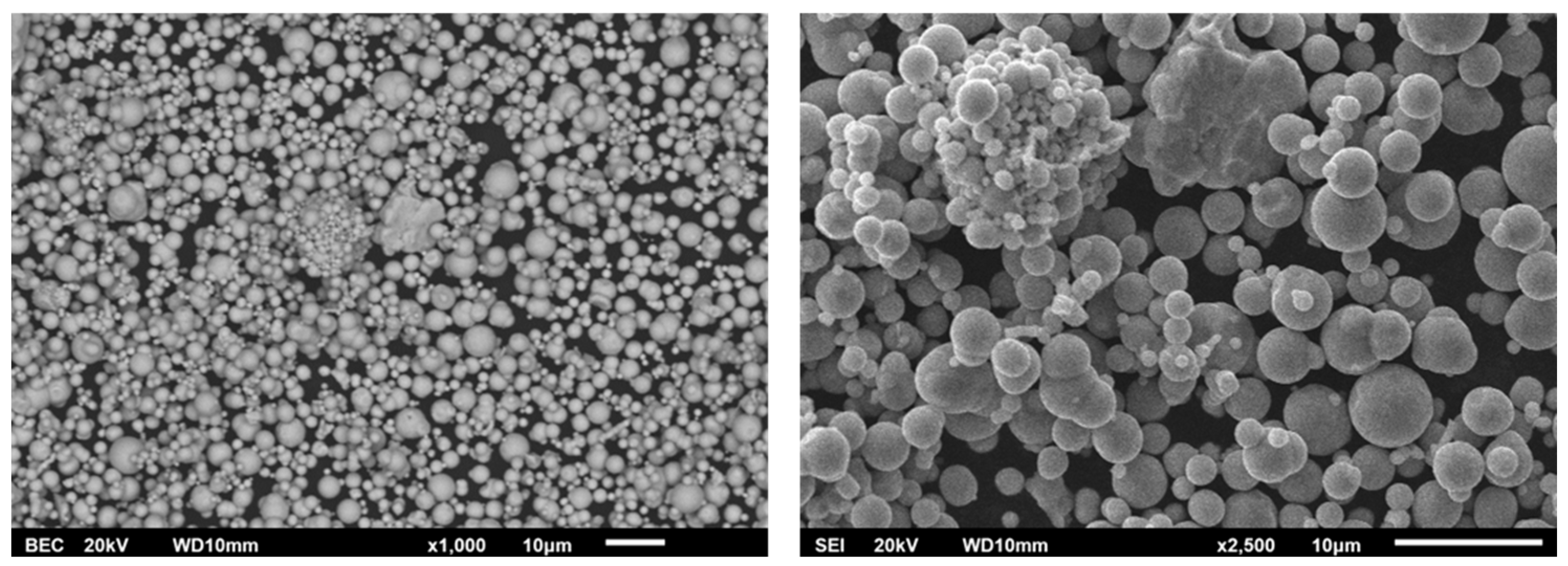



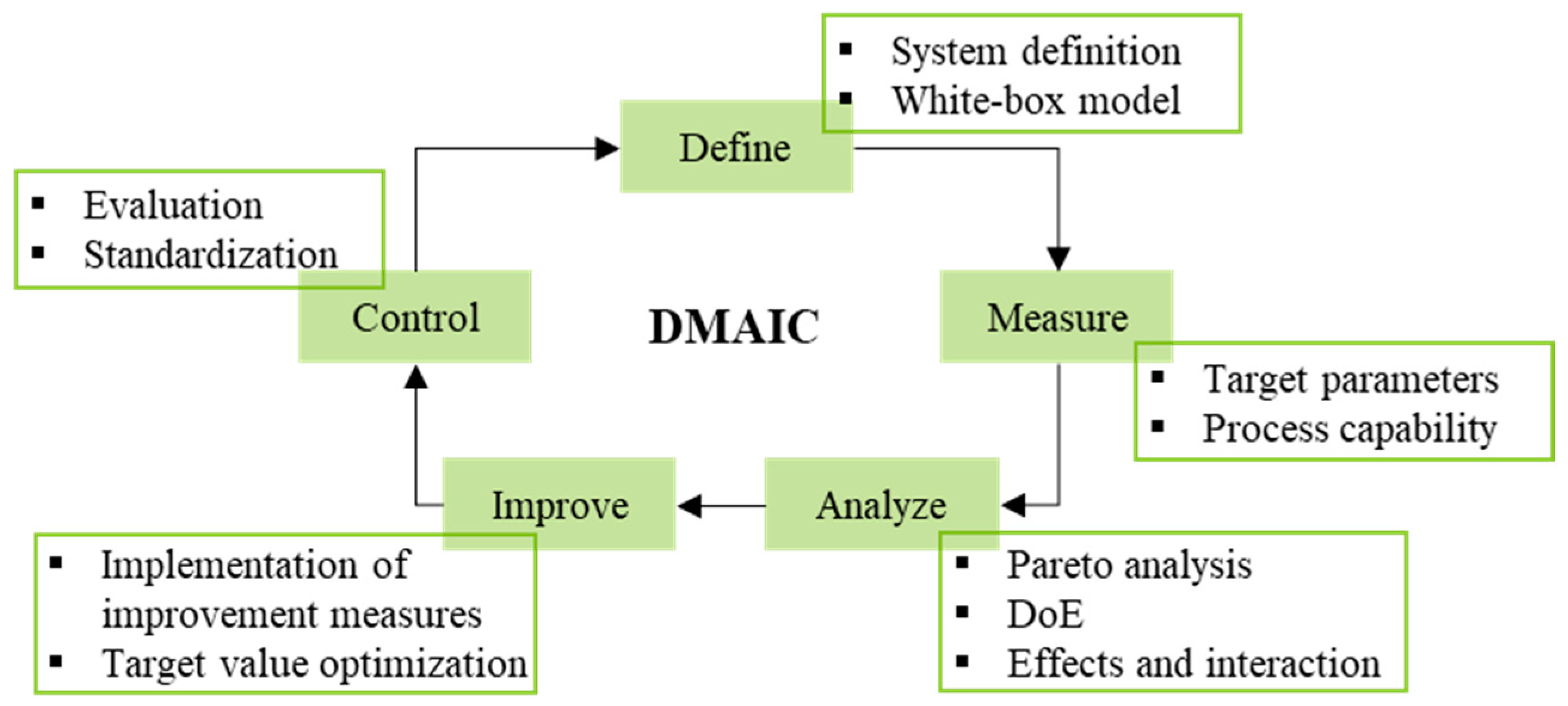
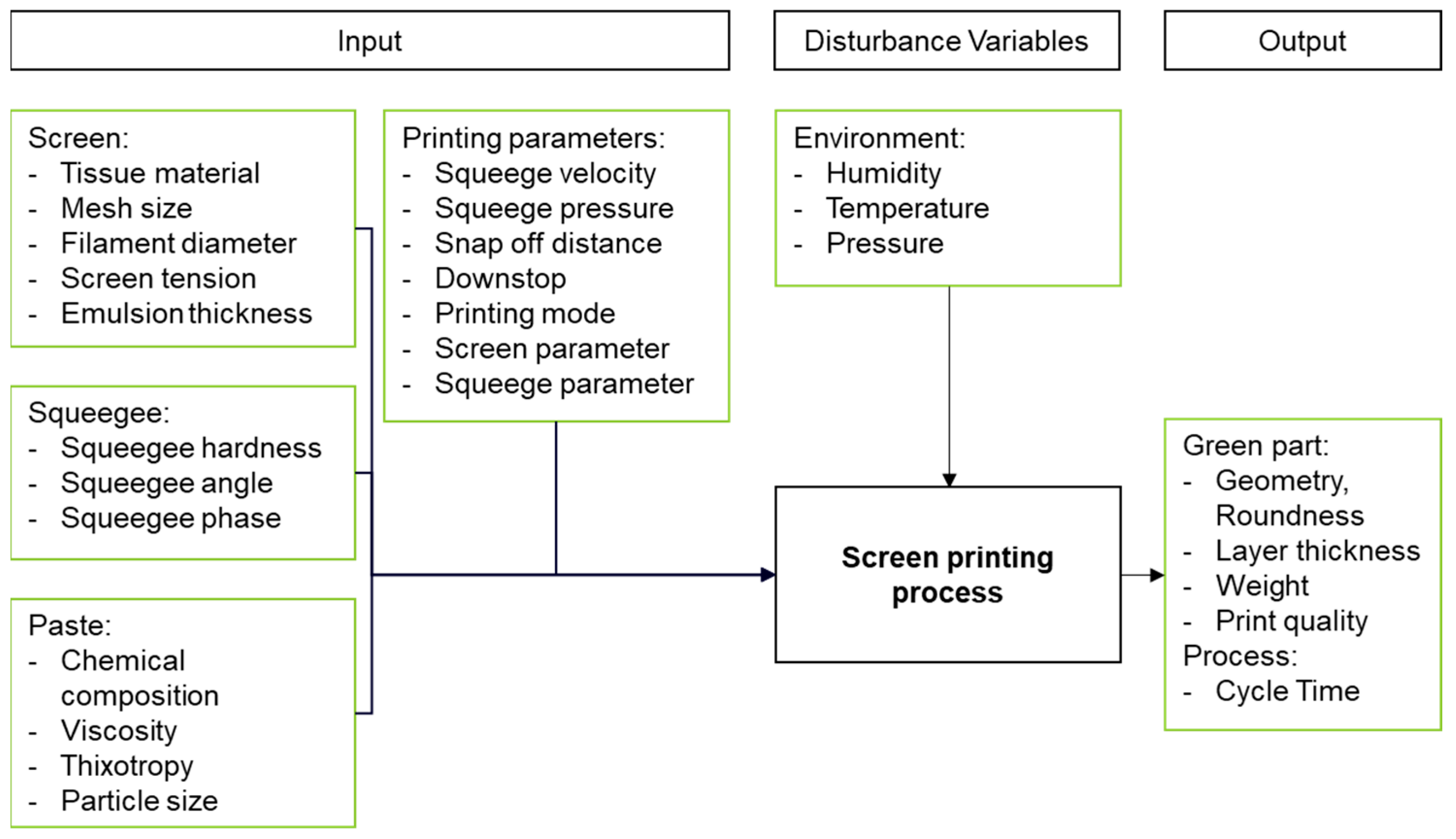
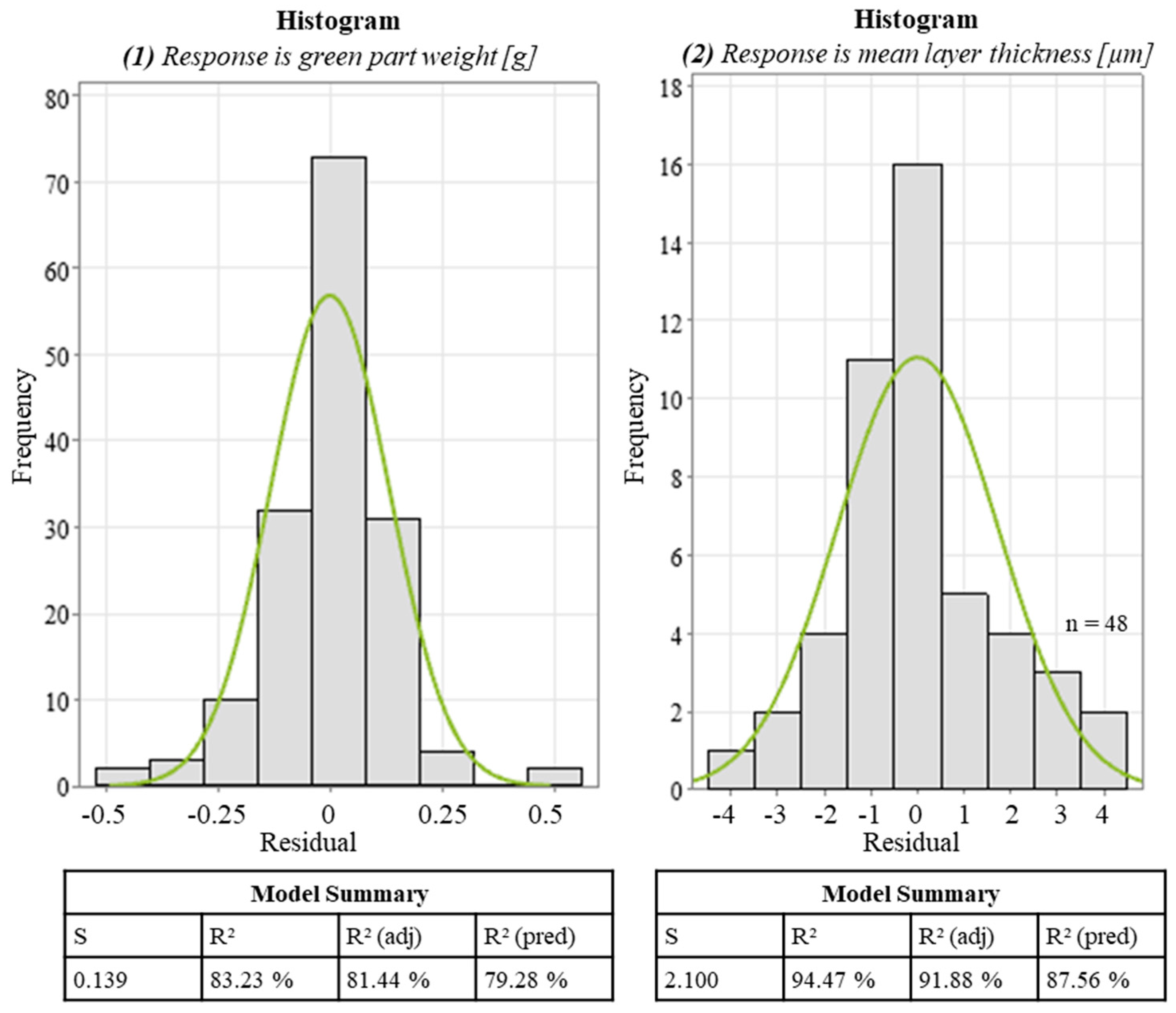


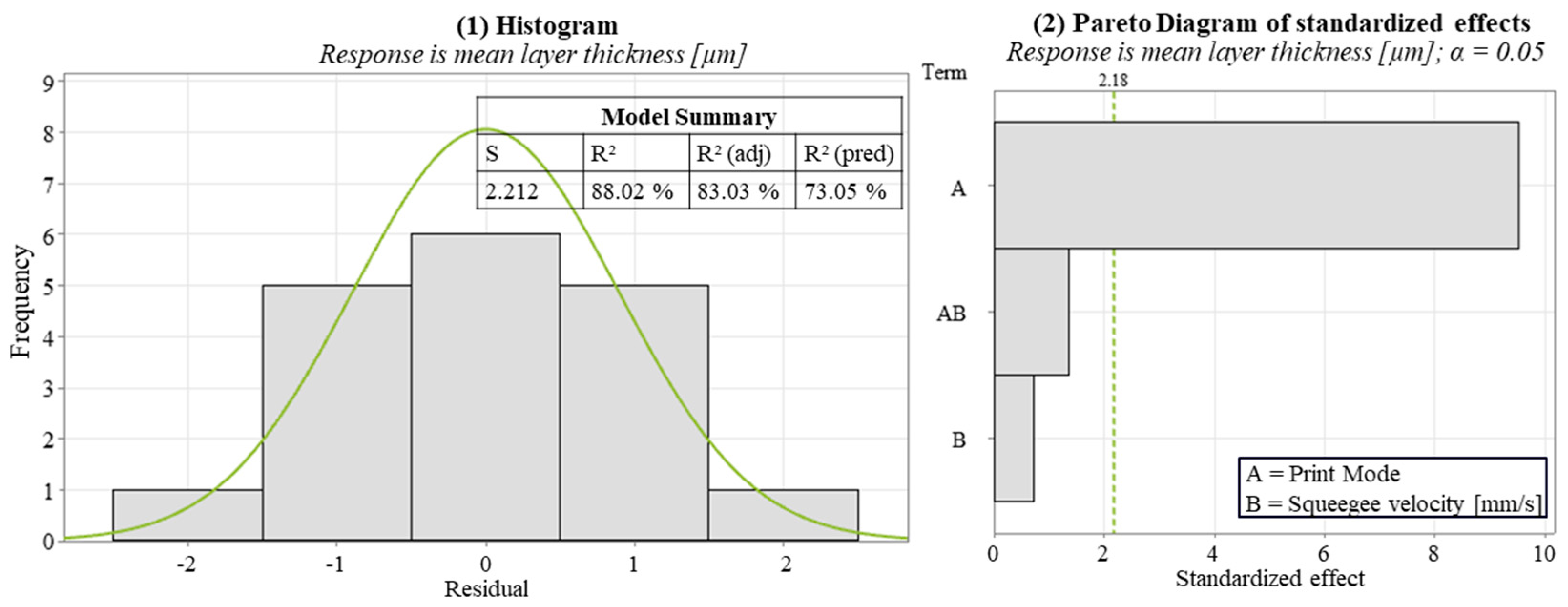

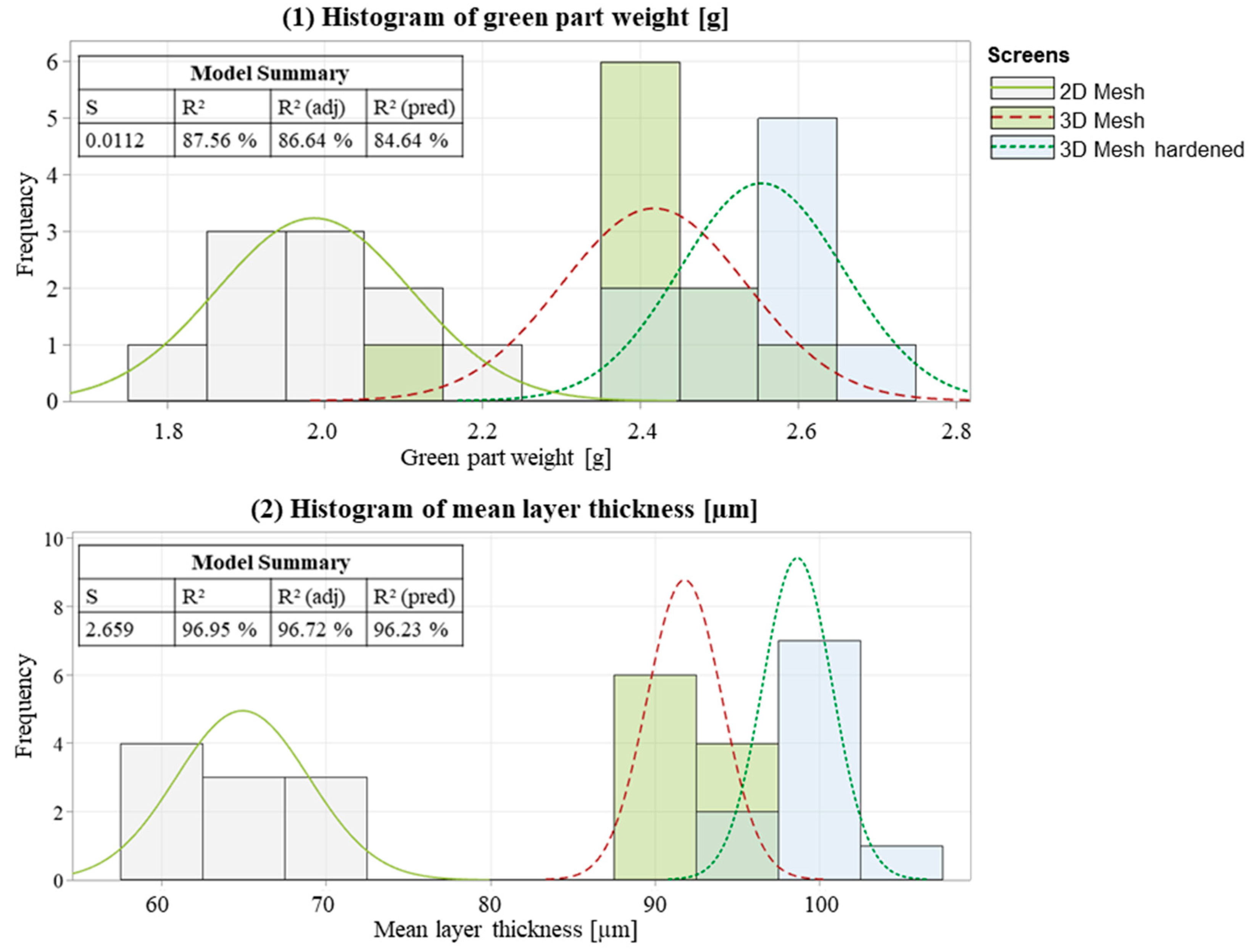
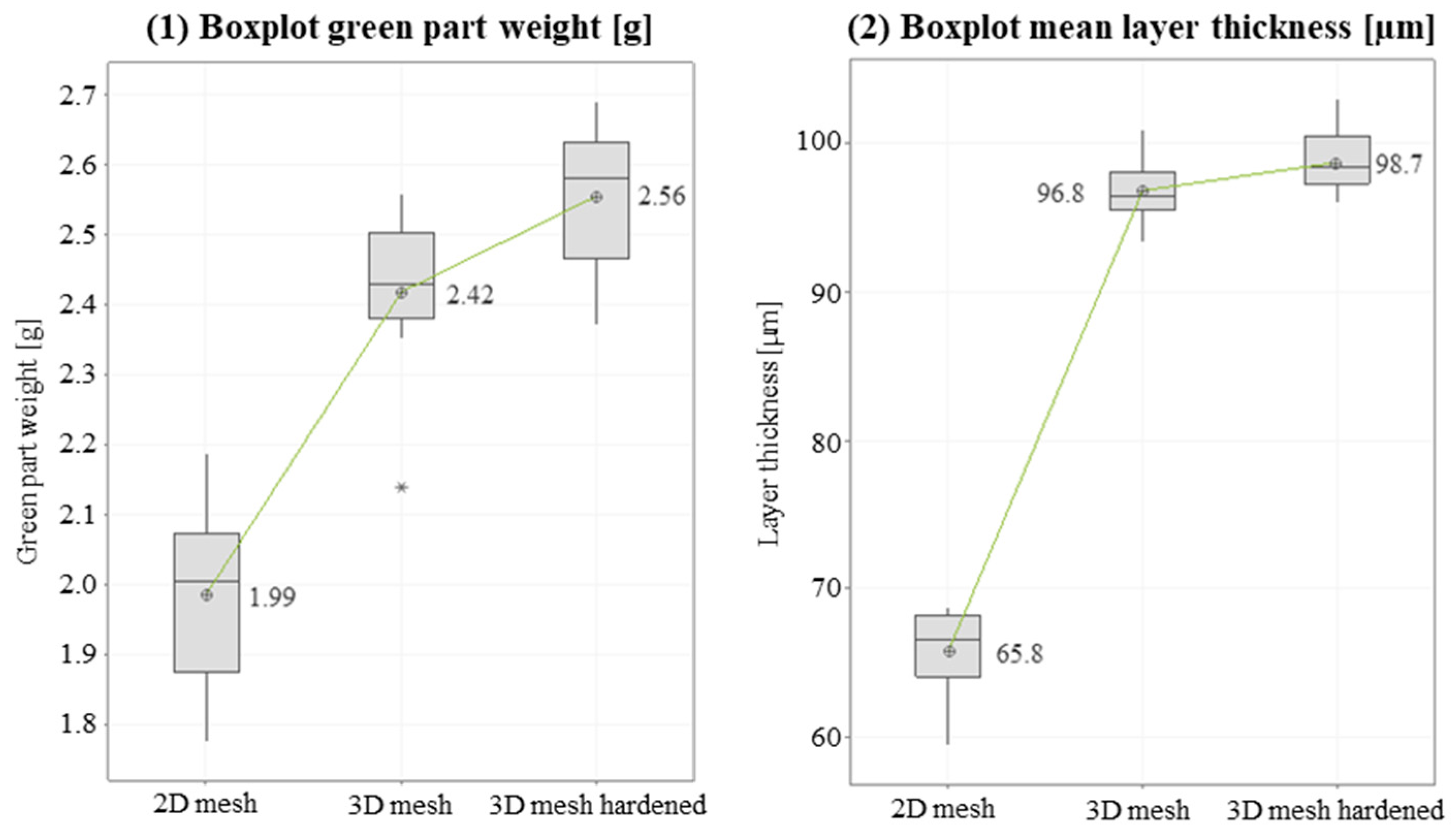
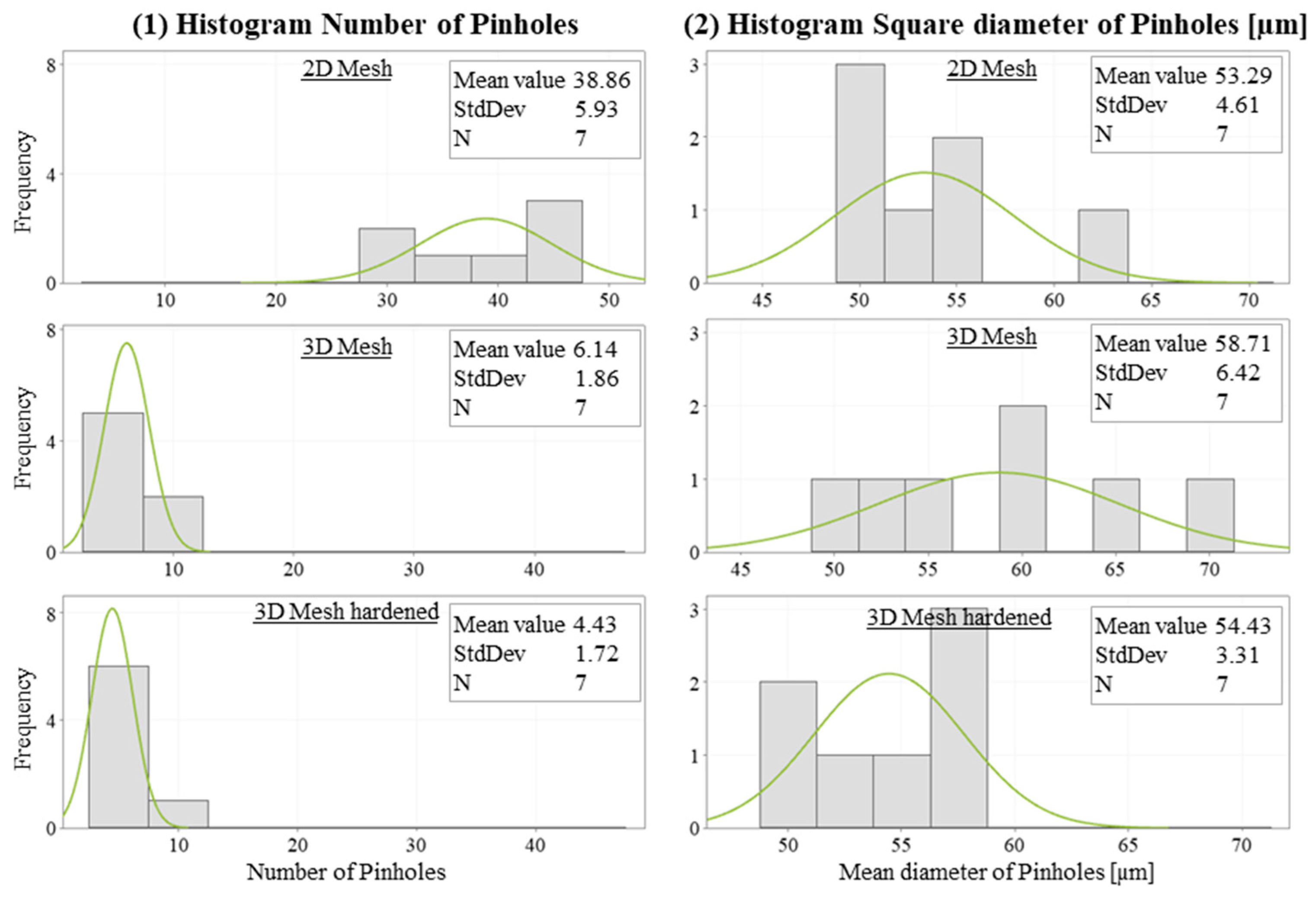

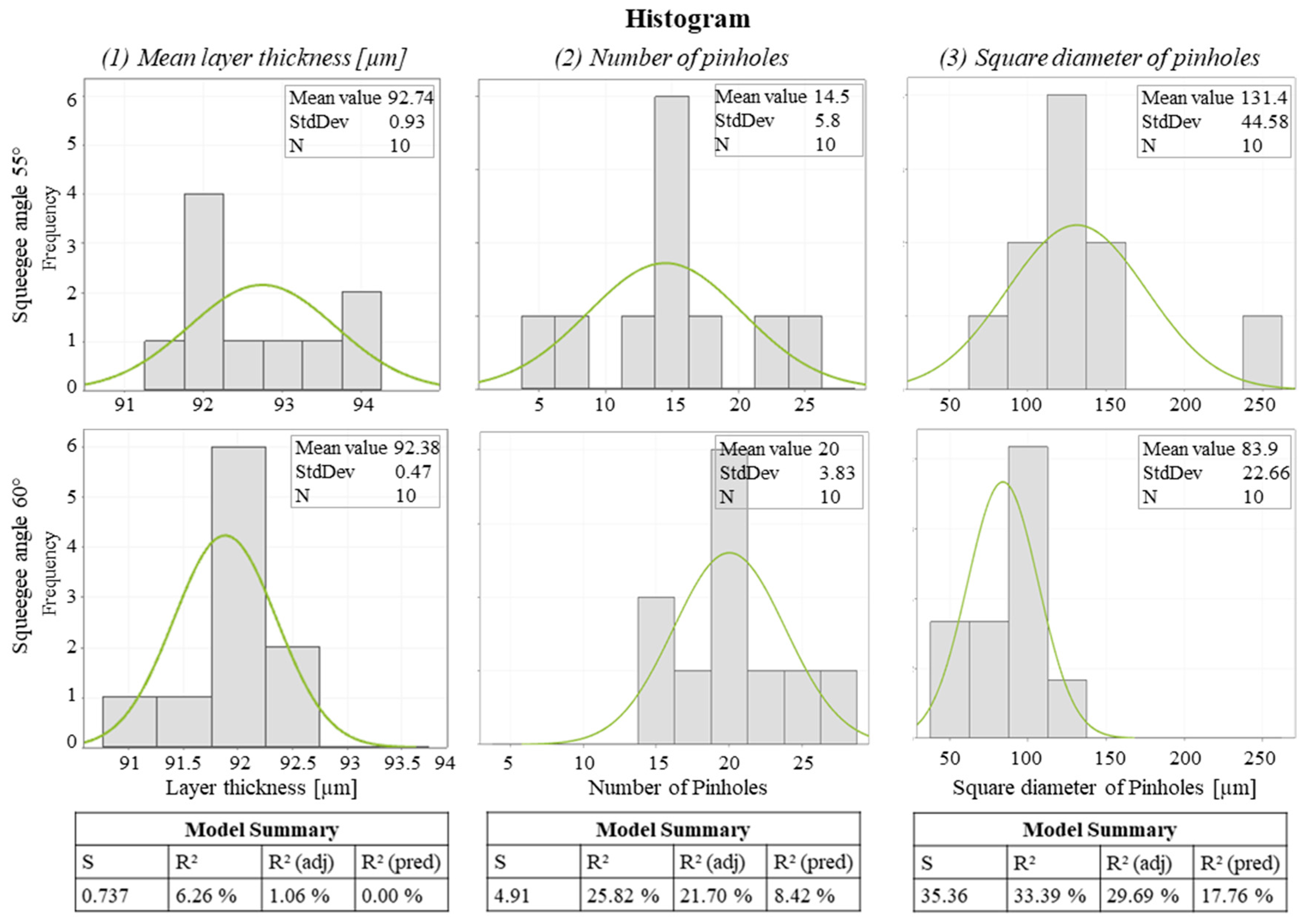
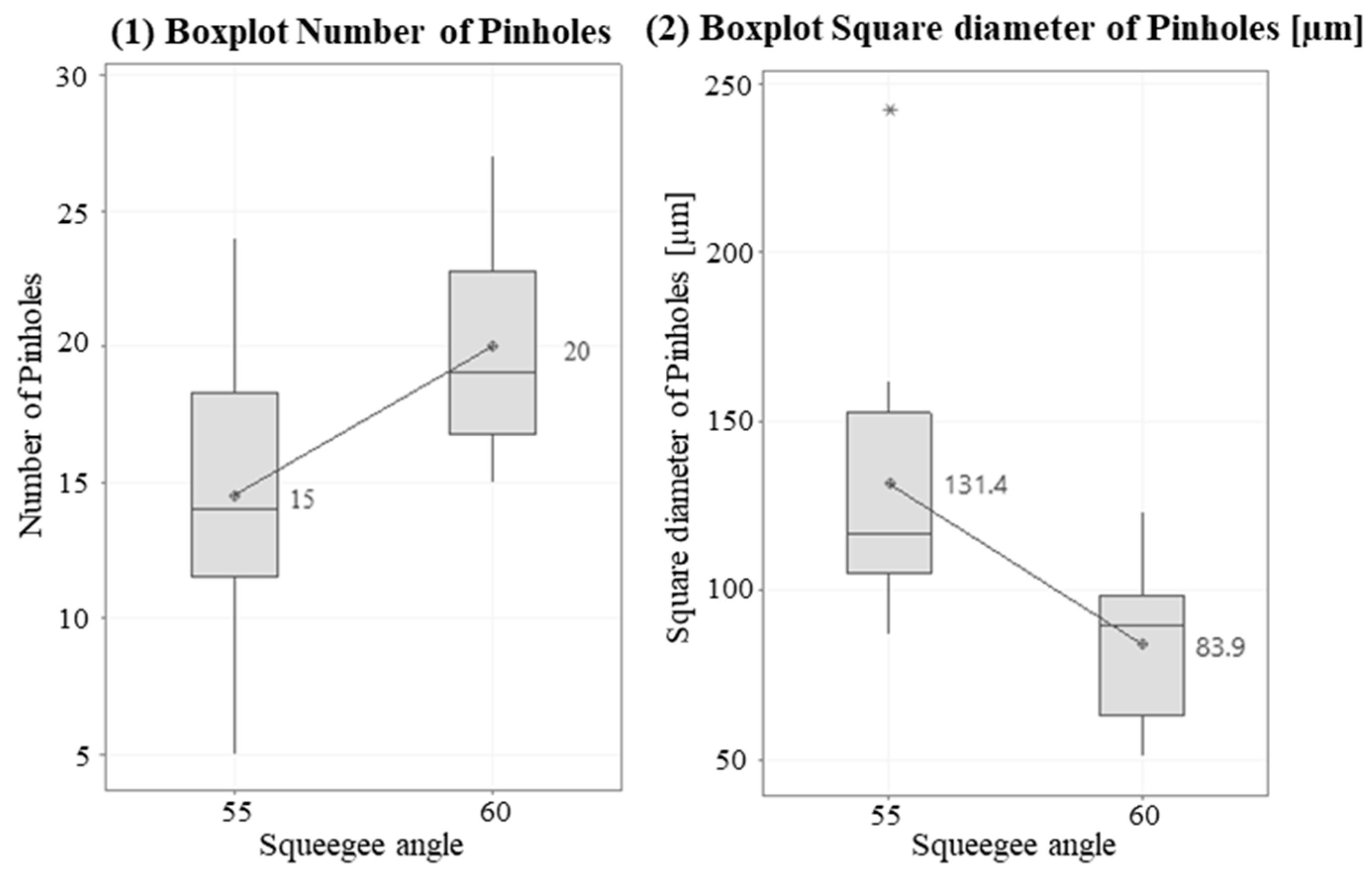
| Target Parameter | Optimum | Target Value | Variables |
|---|---|---|---|
| Cycle time | ↓ | 6 s | Squeegee velocity, print mode |
| Layer thickness | → | 100 µm | Screen, Squeegee, Paste, Printing Parameters |
| Roundness | ↑ | 99.5% | Screen distortion |
| Image quality | ↑ | Qualitative | Screen, squeegee, paste, process parameters |
| Variable | Standard Setting | Adaption in DoE |
|---|---|---|
| Squeegee velocity | 60 mm/s | 1 |
| Take-off | 3 mm | 1 |
| Roller-mill | Yes | 1 |
| Print mode | Flood–print | 2 |
| Screen type | 2D-mesh | 3 |
| Squeegee angle | 60° | 4 |
| Variable | Levels | Values | Unit |
|---|---|---|---|
| Squeegee velocity | 4 | 60; 120; 180; 240 | mm/s |
| Take-off | 2 | 2; 3 | mm |
| Roller-mill | 2 | Yes; No | - |
| Variable | 2D Mesh | 3D Mesh | 3D Mesh Hardened |
|---|---|---|---|
| Screen type |  |  |  |
| Mesh Size [µm] | 245 | 238 | 238 |
| Filament Size [µm] | 65 | 80 | 80 |
| Fabric Size [µm] | 214 | 225 | 225 |
Disclaimer/Publisher’s Note: The statements, opinions and data contained in all publications are solely those of the individual author(s) and contributor(s) and not of MDPI and/or the editor(s). MDPI and/or the editor(s) disclaim responsibility for any injury to people or property resulting from any ideas, methods, instructions or products referred to in the content. |
© 2023 by the authors. Licensee MDPI, Basel, Switzerland. This article is an open access article distributed under the terms and conditions of the Creative Commons Attribution (CC BY) license (https://creativecommons.org/licenses/by/4.0/).
Share and Cite
Schmidt, A.; Wieprecht, N.; Schlichting, J.; Denneler, S.; Franke, J.; Kuehl, A. Process Development of Screen-Printed Magnetic Sheets for Electric Machines via Statistical Design of Experiments. Metals 2023, 13, 1814. https://doi.org/10.3390/met13111814
Schmidt A, Wieprecht N, Schlichting J, Denneler S, Franke J, Kuehl A. Process Development of Screen-Printed Magnetic Sheets for Electric Machines via Statistical Design of Experiments. Metals. 2023; 13(11):1814. https://doi.org/10.3390/met13111814
Chicago/Turabian StyleSchmidt, Alexander, Nico Wieprecht, Johannes Schlichting, Stefan Denneler, Jörg Franke, and Alexander Kuehl. 2023. "Process Development of Screen-Printed Magnetic Sheets for Electric Machines via Statistical Design of Experiments" Metals 13, no. 11: 1814. https://doi.org/10.3390/met13111814
APA StyleSchmidt, A., Wieprecht, N., Schlichting, J., Denneler, S., Franke, J., & Kuehl, A. (2023). Process Development of Screen-Printed Magnetic Sheets for Electric Machines via Statistical Design of Experiments. Metals, 13(11), 1814. https://doi.org/10.3390/met13111814







